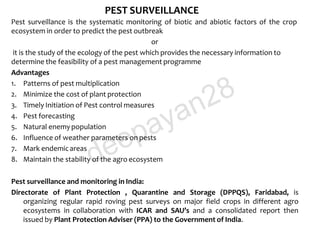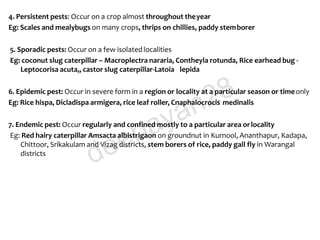Pest-Surviellance.pdf
- 2. PEST SURVEILLANCE Pest surveillance is the systematic monitoring of biotic and abiotic factors of the crop ecosystem in order to predict the pest outbreak or it is the study of the ecology of the pest which provides the necessary information to determine the feasibility of a pest management programme Advantages 1. Patterns of pest multiplication 2. Minimize the cost of plant protection 3. Timely Initiation of Pest control measures 4. Pest forecasting 5. Natural enemy population 6. Influence of weather parameters on pests 7. Mark endemicareas 8. Maintain the stability of the agro ecosystem Pest surveillance and monitoring in India: Directorate of Plant Protection , Quarantine and Storage (DPPQS), Faridabad, is organizing regular rapid roving pest surveys on major field crops in different agro ecosystems in collaboration with ICAR and SAUŌĆÖs and a consolidated report then issued by Plant Protection Adviser (PPA) to the Government of India. deepayan28
- 3. Forecasting for Pest Management Insect forecasting service may serve to find out (1) Prediction of Infestation levels (2) critical stages of insecticide application 1941- Nation wide pest forecasting system was established inJapan 1939- Locust warning station in India was established Forecasting is mainly of two types 1) Short term: Covers one or two seasons mainly based on the populations of the pest within the crop by sampling methods 2) Long term: Covers large areas and based mainly on the possible effects of weatheron the insect abundance. Eg. Locust warning stations Forecasting is made through 1. Population studies carried over severalyears 2. Studies on the pest life history 3. Field studies on the effect of climate on the pest and itsenvironment 4. Predictions form the empirical data on the pests of the previous season deepayan28
- 4. INSECT PESTS -Latin word ŌĆśPestisŌĆÖ meaning Plague ŌĆó An insect reaches status of a pest when its number increases and inflicts significant damage ŌĆó ŌĆśPestŌĆÖ is an insect or other organism that causes damage to crops, stored produce and animals ŌĆó Damage boundary is the lowest level of injury where the damage can bemeasured Insect pests are divided into 1) negligible- less than 5% loss in yield 2) minor- loss ranging from 5 to 10% 3) major- a loss of 10% or more Different Categories of Insect Pests 1. Regular pest: Occur frequently in a crop and have close association with that particularcrop Eg: Chilli Thrips Scirtothrips dorsalis , brinjal shoot and fruit borer, Leucinodesorbonalis 2. Occasional pests: No close association with a particular crop and they occurinfrequently Eg: Rice case worm, Nymphula depuctalis, mango stem borer, Batocerarufamaculata 3.Seasonal pests: Occur during a particular part of year, incidence is governed by climate Eg: Red hairy caterpillar on groundnut-June ŌĆōJuly Rice grasshoppers ŌĆōJune-July deepayan28
- 5. 4. Persistent pests: Occur on a crop almost throughout theyear Eg: Scales and mealybugs on many crops, thrips on chillies, paddy stemborer 5. Sporadic pests: Occur on a few isolatedlocalities Eg: coconut slug caterpillar ŌĆō Macroplectra nararia, Contheyla rotunda, Rice earhead bug - Leptocorisa acuta,, castor slug caterpillar-Latoia lepida 6. Epidemic pest: Occur in severe form in a region or locality at a particular season or timeonly Eg: Rice hispa, Dicladispa armigera, rice leaf roller, Cnaphalocrocis medinalis 7. Endemic pest: Occur regularly and confined mostly to a particular area orlocality Eg: Red hairy caterpillar Amsacta albistrigaon on groundnut in Kurnool, Ananthapur, Kadapa, Chittoor, Srikakulam and Vizag districts, stem borers of rice, paddy gall fly in Warangal districts deepayan28




